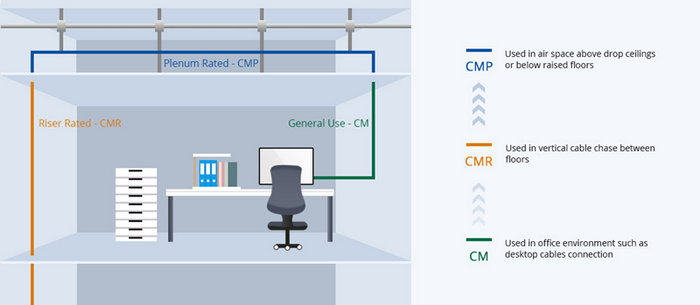When it comes to choosing the right cable for your networking needs, one question that often pops up is whether CMR (Communications Multipurpose Cable, Riser) cable is plenum rated. It's crucial to get this clear right from the start: CMR cable is not plenum rated. The two terms represent different types of fire ratings for cables and are used in distinct scenarios.
Understanding the distinctions between these two types of cables can save you a lot of trouble down the line. Plenum-rated cables are designed to meet strict fire safety test standards and are required for use in any "air handling" space. That includes areas where air circulates within a building, like drop ceilings or raised floors—spaces that often serve as returns for heating, ventilation, and air conditioning (HVAC) systems.
On the other hand, CMR cable has a lower fire rating than plenum cable and is typically used in vertical riser applications—that means they're intended for non-plenum vertical runs spanning more than one floor. However, they're not suitable nor safe to use in air handling spaces as their coatings do not effectively limit smoke emissions during a fire like those on plenum-rated cables do.
Understanding Cable Ratings: Plenum Vs. CMR
Embarking on a wiring project? You're likely to stumble upon terms like Plenum and CMR. To make an informed decision, it's crucial to understand the distinctions between these cable ratings.
First off, let's tackle plenum-rated cables. These are designed for use in air circulation spaces, or 'plenum' areas. They're manufactured using materials that resist burning and don't emit harmful fumes when exposed to fire - a key consideration for safety regulations in many buildings. In case of a fire outbreak, you'd want your wires not adding toxic smoke into the mix.
On the flip side, we've got Communications Multipurpose Cable (CMR) – also known as riser-rated cable. These are specifically engineered for non-plenum vertical applications such as between floors through cable risers or elevator shafts. They possess fire-resistance properties too but aren't mandated to be as stringent as their plenum counterparts.
Here's where you might ask: why go with one over the other? Well, it largely comes down to your specific application and local building codes:
- If you're wiring within plenums (the spaces used for air circulation like HVAC ducts), then plenum-rated cables are what you need.
- However, if it's about connecting different floors without going through air circulation areas – that’s where CMR-rated cables come in handy.
Remember though - both types have their merit with regard to safety standards and performance abilities. It comes back again to the specifics of your project and matching them with appropriate cabling solutions. Not sure? Consult an expert or local authority on building codes before making that final call!
What is a Plenum Rated Cable?
Ever found yourself puzzled by the term 'plenum rated cable'? You're not alone. It's a term that gets thrown around in the world of electronics and cabling, often leaving people scratching their heads. Let's unravel this mystery together.
Plenum rated cables refer to those specifically designed to be installed in plenum spaces of your building. Now, you might ask, what exactly are these plenum spaces? Well, they're areas used for air circulation for heating, ventilation and air conditioning (HVAC) systems. These include spaces above drop ceilings or under raised floors.
Why should you care about whether a cable is plenum rated or not? Here's why: safety first! Plenum spaces often become channels for smoke and flame spread in case of fire. Plenum rated cables are made with special materials that limit the release of toxic fumes when subjected to fire.
Let's get technical for a moment here - The National Fire Protection Association (NFPA) standard 90A mandates the use of plenum-rated cables in these spaces because they have passed stringent burn tests outlined in Underwriters Laboratories (UL) safety standard 910.
So, next time someone mentions 'plenum rated', you'll know they're talking about cables specially designed to keep your building safer during fires by limiting toxic fume emissions.
CMR Cables: A Brief Overview
You're probably asking, "What exactly is a CMR cable?" Well, let's break it down. Standing for "Communications Multipurpose Cable, Riser", CMR cables are primarily used in vertical riser applications. They're designed to prevent the spread of fire from floor to floor in commercial buildings. Here's why that's important - if a fire breaks out, you don't want it spreading rapidly through your building via the cabling system.
So how do these cables accomplish this? It's all about the jacket material. The outer layer of a CMR cable is made from PVC (Polyvinyl Chloride) which has flame-retardant properties. That means if there's a fire, these cables will resist ignition much longer than standard cables.
Now you might be wondering where you'd typically find these types of cables? Most often they're seen in non-plenum areas like between floors or elevator shafts where ventilation is limited. Remember! While they can be used in both commercial and residential settings, their primary purpose isn’t running lines inside walls or ceilings.
But here’s something crucial to note - while CMR-rated cables are flame retardant, they aren't immune to burning completely and when they do burn, they can release toxic fumes due to the PVC coating. Safety measures need certainly still be considered!
Lastly, just because a cable is 'riser-rated' doesn't mean it’s suitable for every environment. There are stricter classifications such as plenum-rated (CMP) which are required for spaces with forced air circulation like drop-ceilings and raised floors often found in office buildings or data centers.
In short:
- Use CMR rated-cables for vertical runs
- Know that while flame-retardant, they can still burn
- Understand that not all environments suit these type of cables
There you have it! A brief overview of CMR cables. Always choose the right cable for your specific needs and safety requirements.
Is CMR Cable Plenum Rated? Unraveling the Truth
You're no doubt wondering, is Communications Multipurpose cable (CMR) plenum rated? Let's get straight to the point - it's not. You've been scratching your head, trying to sort through jargon and technical terms: now you have a clear answer.
Why isn't it plenum rated? Well, CMR cable is specifically designed for general use within buildings. It's structured to prevent the spread of fire between floors through risers or vertical shafts, but it doesn't hold up in plenum spaces. These areas include any space used for air circulation in heating and air conditioning systems, such as above dropped ceilings or under raised floors. They require cables with a higher fire-resistance rating because of increased airflow that can accelerate a fire.
Of course, there are cables made for these challenging environments. Cables labeled CMP (Communications Multipurpose Plenum) are created with fire-retardant materials that don't produce large amounts of smoke when burnt. So if you're dealing with wiring in plenum spaces, CMP should be your go-to choice.
It's important not to mix things up here:
- CMR - suitable for riser applications.
- CMP - your best bet for wiring in plenums.
Now you're probably thinking about cost implications. It's true; CMP does come at a higher price tag compared to CMR due to its additional safety features and increased production cost. However, consider this an investment in safety rather than an unnecessary expense.
So there you have it! The truth has been unraveled – while CMR cable offers some degree of fire protection; it simply doesn't cut it when we talk about being 'plenum-rated'. Safety first: always ensure you’re using the right type of cabling for your specific environment!
Key Differences Between CMR and Plenum Cables
When you're in the market for networking cables, two common types you'll encounter are CMR (Communications Multipurpose Cable, Riser) and plenum. They're not interchangeable - understanding the differences between them is crucial to ensure safety and optimal performance.
First off, let's talk about where these cables are used. Your choice largely depends on where you're planning to install the cables. CMR cables are typically designed for use in vertical riser applications such as between floors through cable risers or elevator shafts. They resist the spread of fire but aren't rated for areas with heavy air circulation because they can potentially release toxic smoke when burned.
On the other hand, plenum cables get their name from HVAC 'plenum' spaces - areas that facilitate air circulation for heating and cooling systems, like drop ceilings or raised floors. If a fire were to occur, these spaces could quickly distribute smoke throughout a building. Therefore, plenum-rated cables are made of flame-resistant material that emits limited smoke.
The difference also lies in their construction material. The outer jacket of CMR cable uses PVC (Polyvinyl Chloride), which while cheap and flexible, produces thick black smoke and hazardous gases when it burns. In contrast, plenum cables use either FEP (Fluorinated Ethylene Propylene) or low-smoke PVC that burns cleaner with less toxic output.
Finally, there's a cost difference too! Due to their safer burning characteristics and stricter manufacturing standards required by the National Electric Code (NEC), it's no surprise that plenum cables come with a higher price tag compared to CMR alternatives.
To sum up:
- CMR Cables: Used in riser applications; cheaper but produce harmful gases when burned.
- Plenum Cables: Suitable for plenums spaces; pricier but safer due to clean-burning materials.
Understanding these differences will help you make an informed decision when selecting the right cable for your project. Don't forget to check building codes in your area as they often dictate which type of cable is permissible!
Safety Considerations: Fire Resistance of CMR and Plenum Cables
When it comes to safety, you can't overlook the importance of fire resistance in cables. If you're considering Communications Multipurpose Cable (CMR) or plenum cables for your networking needs, understanding their fire-resistant properties is vital.
Plenum cables are a cut above when we're talking about fire resistance. They're specifically designed for use in plenum spaces - those areas used for air circulation in heating and cooling systems, where flame spread can be a major concern. These cables contain a special material that not only resists igniting but also produces less smoke than typical cabling materials.
On the other hand, CMR cable, also known as riser-rated cable, doesn't quite match up to plenum cable's superior fire resistance. It's crafted with a different purpose – to prevent fires from spreading floor-to-floor through risers or vertical shafts. While they aren’t as resistant as plenum cables, they do meet certain standards set by the National Electrical Code (NEC).
Let’s compare them side by side:
| CMR Cable | Plenum Cable | |
| Fire-Resistance | Medium | High |
| Smoke Production | Higher | Lower |
But remember, it's not just about picking the most fire-resistant option on principle alone. You've got to consider the specific requirements of your building and local codes before making your choice.
In some instances, local regulations may require the use of plenum-rated cables even outside of plenum spaces due to their superior safety characteristics. So always double-check these factors before finalizing any purchase decision.
Choosing Between CMR and Plenum for Your Application Needs
It's a decision that often stumps even the most seasoned experts. When it comes to cable installation, what should you choose: Communications Multipurpose Cable, Riser (CMR), or Plenum? The answer isn't always straightforward because your choice largely depends on various factors such as building codes, budget constraints, and the specific needs of your application.
First off, let's discuss CMR. This type of cabling is typically used in non-plenum spaces where cables are run between floors through risers or vertical shafts. What makes CMR an attractive option is its affordability compared to plenum-rated cables. However, you'll need to remember that while it's less costly upfront, this type of cable has lower fire resistance standards than plenum cables.
On the other hand, we have plenum-rated cables. These are designed for use in air-handling spaces (plenums) wherein environmental air is transported. If a fire breaks out in these areas, smoke and toxic fumes can quickly spread throughout the building via the HVAC system. So why opt for plenum cabling? It's simple - safety first! While they may come with higher price tags initially, these cables adhere to stricter fire safety regulations which could potentially save lives in case of a fire incident.
Now when selecting between CMR and plenum for your application need to consider:
- Building codes: Always check local building codes first before deciding which cable type to use.
- Budget: Determine if your budget can accommodate pricier but safer plenum-rated cables or if cost-effective yet less resistant CMR would be feasible.
- Application requirements: Lastly, assess whether more rigorous fire safety standards are essential based on where and how you intend to install these wires.
In essence, then both types bring their unique advantages to the table - whether it be cost-effectiveness or higher safety standards. So don't rush your decision. Instead, take the time to understand these factors and choose what's best suited for your specific needs.
Conclusion: Making an Informed Choice
Your decision between CMR and plenum-rated cables should always be driven by your specific needs, the environment of installation, and local building codes. You've learned that while both types of cables have their own strengths and appropriate uses, they're not interchangeable.
Plenum-rated cables are designed for use in air-handling spaces (plenums) because they emit less toxic smoke when burned. They're made with fire-resistant material which makes them more expensive than other cable types. Should you need to run a cable through a plenum space like ceiling or floor cavities used for air circulation, it's imperative you choose plenum-rated cables.
On the other hand, CMR (Communications Multipurpose Cable Riser) is aimed at preventing fires from spreading between floors through risers or vertical shafts. If your project involves wiring between floors without using the airflow areas, then CMR would be your go-to choice.
Remember these key points:
- Plenum-rated cables are ideal for plenums due to their low-smoke-producing properties.
- CMR-rated cables are great for installations involving floor transitions but outside of plenums.
- Always adhere to local building codes when deciding on cable type.
- Consider the cost difference; Plenum cables tend to be pricier due to their fire-resistant characteristic.
Ultimately, making an informed choice about cabling comes down to understanding where it'll be utilized and abiding by safety standards set out by regulatory bodies. It's crucial not just for compliance's sake but also to ensure the overall safety of people within the premises.

Mastering the Art of Audio Upmixing
UniFab Audio Upmix AI is revolutionizing the way audio production is approached in various industries. By utilizing cutting-edge artificial intelligence technology, UniFab Audio Upmix AI offers a unique and innovative solution for upmixing audio content to deliver superior sound quality.

Revolution on the Used Device Market: How Automation is Leading the Way
The main trend in the used device market is automation. All processes that are done manually have one common drawback: human errors.

What are the advantages of using a woman owned staffing agency?
While selecting a staffing agency in the current evolving and inclusive business environment the significance of diversity and equality cannot be ignored. It has become more evident than before. Businesses can actively add to this objective and enjoy an inclusive and gender equal workforce by partnering with a women recruitment agency. Teaming up with an agency can help you enjoy a completely unique perspective about recruitment, gender diversity and values to the hiring process.

The Art of Selecting the Perfect Bouquet for Every Occasion: A Comprehensive Guide
In the world of floral gifting, selecting the perfect bouquet is an art form that goes beyond simply choosing pretty flowers. Each occasion carries its own significance and sentiment, and the right bouquet has the power to convey exactly the message you intend. Whether you're celebrating a joyful milestone, expressing condolences, or simply saying "I love you," understanding the nuances of flower selection can elevate your gift to a meaningful expression of emotion. In this comprehensive guide, we'll delve into the art of selecting the perfect bouquet for every occasion, offering expert tips and insights to help you navigate the world of floral gifting with confidence and flair.

How many eSIMs can be used in iPhone?
Are you looking to streamline your mobile experience with an eSIM for your iPhone? The advent of eSIM technology has revolutionized the way we connect, allowing for a more seamless and efficient use of our devices. With an eSIM iPhone, you can forget about the hassle of physical SIM cards and enjoy the benefits of multiple network plans on a single device. But how many eSIMs can an iPhone support? And how do you go about adding an eSIM to your iPhone? In this article, we'll dive into the ins and outs of eSIM capabilities on your SIM iPhone, providing you with a step-by-step guide to getting set up. Keep reading to unlock the full potential of your iPhone with eSIM technology and learn how to enhance your connectivity with ease.

IMEI Info Checker App
The awaited moment has arrived! After a period of anticipation, we take immense pride in announcing the launch of the IMEI Info Checker App, marking a pivotal moment in accessing concealed mobile device information. In today's digitally intertwined landscape, understanding your device's nuances is pivotal. This long-awaited unveiling undoubtedly simplifies access to concealed information about any mobile device. Soon available on the App Store for iOS and the Play Store for Android, this app promises a transformative shift in how users interact with their device data.

iPhone GSX Check
Are you seeking essential details about your iPhone's carrier network, warranty status, and other critical information? The iPhone GSX Check provides comprehensive insights into various aspects like simlock network, Find My iPhone status, warranty info, and more.

eSIM Quick Transfer - All You Need to Know
In the ever-evolving landscape of smartphone technology, eSIM (embedded SIM) has emerged as a game-changer, offering greater flexibility and convenience for users. One of the latest innovations in this realm is the eSIM Quick Transfer feature, which streamlines the process of transferring eSIM profiles between devices. Whether you're an iPhone aficionado or an Android enthusiast, understanding the ins and outs of eSIM Quick Transfer is essential for maximizing the potential of your mobile experience.



















